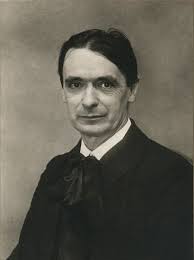The
San Jose Repertory Company is dead. They went bankrupt. Saddled with over 3 million dollars in debt, they just couldn't stay afloat, and this happened in one of the wealthiest cluster of zip codes in America. As a San Jose State University Theater Department alumnus, I was more than a little bummed out by this development, but not enough to say I really cared. What?! How could I not care? What has happened? Has the market has changed? Have the times changed? As Douglas Coupland said in Generation X, "We live in an accelerated culture." Is it possible, that perhaps theater, as produced by the regional companies like the San Jose Repertory doesn't matter much anymore to the modern entertainment consumer.
But why didn't I care? That question has plagued me.
 |
| Meyerhold by Boris Gregoriev 1916 |
In order to understand the collapse of the San Jose Repertory company--one of many regional theater companies to shutter their doors in the last 20 years, one first must look at a brief history of theatrical entertainment, particularly the history of Vaudeville in America, which itself affected the development of so called "legitimate" theater. The advent of vaudeville paralleled the rise of the US industrial revolution. The migration of workers from the fields to the factories changed everything, and as the pace quickened towards the end of the 19th century, the traditional rural forms of entertainment, in the form of migratory music hall comedians, and travelling minstrel shows, and the spiritual/philosophical tent gatherings of Chautauquas,--all with roots in Europe--gave way to larger, more formalized acts. The PT Barnum's and BF Keith's rose as impresarios. Even though hours were long for our urban folk, there was time off. This radical shift created a miraculous situation. Workers had leisure time! More importantly, wives and children who did not work in the factories, had leisure time too. And even if it was an hour, that was enough for a reasonably priced show at a spectacular vaudeville palace. Unlike performances of today, where we go to the theater, usually in the evening, as a special event, vaudeville shows, in contrast were all day events. B.F. Keith ushered in the age of "continuous performance". Concerned about losing the audience, he had shows that ran from 11 am until 11 at night! And these were family friendly entertainments geared to reassure the city folk that the American dream was alive and well, even if it had shifted towards a materialistic dream and away from their traditional ethnic folk cultures.
Albert F. McLean Jr wrote an incredible social science book called
Vaudeville as Ritual which brilliantly portrays how formal entertainment developed as ritual to nurture the myth of the American Dream. Further, McLean "evaluates vaudeville as a symbolic manifestation of values shared by the American people during the period 1885-1930...." He argues that the Myth of success, (American Dream), was given it's tangible form by the likes of Houdini, who could literally break the chains of technology, and the fast talking vaudevillian comedians who offered a paradigm of urban life, and how the melodramatic playlets, with their contrived story lines that mixed sentimentality with a thin veneer of sophistication, actually gave urban Americans a dramatic demonstration of what it means to be "glamorous". This obsession with celebrity and success, traces it's roots backwards from today's celebrities like Angelina Jolie, to the likes of Marilyn Monroe, and further back to Mae West. Of course, there are thousands of other stars to look at also. In fact the first movie stars all got their start in vaudeville (W.C. Fields, the Marx Bros., Charlie Chaplin, Buster Keaton, et al).
Time marches on though, and the vaudeville "palace" theatres gave way to silent movies, silent movies gave way to talkies, movies gave way to television and the TV networks became the new impresarios. And these networks reluctantly gave way to cable which gave way to the Internet, and now streaming of movies, TV, and music. It seems our American obsession with "continuous performance", as taught to us by B.F. Keith, has morphed into an almost insatiable appetite for instant gratification. Thus, the death of regional theatre with all it's trappings, and out-dated ritual. It appears people just don't have time for it, and if they can get their fix electronically, then so be it.
Furthermore, I believe, and it is self evident in their bankruptcy, that SJRC suffered an economic backlash. Customers voted with their feet and wallets. Perhaps they voted against "theatre" elites who feel they know better, who dream of generating political, or social change by producing socially conscious shows, shows that used to affect audiences, like
Master Harold and the Boys, or
Angels in America. Don't get me wrong. These plays are incredible works of art, but once they were produced on cable TV, there was little reason to see it live.
Time, technology, and traffic have conspired against us. Home delivery of fast food beckons us to stay home; electric garage door openers squash any incidental interaction we might otherwise have with our neighbors; google maps has given us the absolute knowledge that allows us to proclaim, "Yes, indeed, the 87 northbound is stop and go for 3 miles, so there's no way in hell I'm going downtown."
Another reason may be in the poor choice of material, in a desperate attempt to fulfill some diversity clause in their grants, theatres like SJRC decide to showcase some part of the world that needs illuminating. Case in point,
the San Jose Mercury News
article states one of the last plays the SJRC did was called
Disconnect, about an Indian call center. I didn't see it, and by box office receipts, it didn't do well.
I'll confess. I don't go to much theater. I don't even spell it as theatre anymore, and in my darker moments, I even ponder how bussing kids to the "theatre" only sets them up to lose that future spelling bee when the misspell "theater" as "theatre", but there is still hope.
The best theater I have seen in recent memory was at, of all places, the LA Renfaire. A family circus troupe called Clan Tynker, performed at one of the pavilions. They are a travelling brother and sister troupe from New Mexico, made up of a stilt walking master of ceremonies, surrounded by his siblings in interchangeable roles of juggler, clown, fire eater, sword swallower, acrobat, magician. We saw them twice, and much to our surprise, their second show was totally different. The crowd was multi-cultural, admittedly a niche group, with the obligatory turkey legs, honey mead, and dill pickles firmly plonked in cascading cleavage, but they loved Clan Tynker! They told us they were paid a base stipend to appear, but they really needed tips to survive, and it was with great pleasure that I watched their ritual, and how they cajoled the crowd into supporting them by offering cold, hard cash on the spot. It was proof positive that ancient theater forms held their own in a modern world, that physical archetypes (clown, magician, gypsy, mystic) transcend language, which leads me to
Meyerhold. Vsevolod Meyerhold was both a student of Constantin Stanislavski and also a competing teacher of a more presentational as opposed to psychological approach to acting. My next blog will examine how these two titans of Russian theatre collaborated, and ultimately diverged, with one dying of old age as a celebrated innovator and defender of Russian greatness, and the other being accused of being a Western spy, subsequently tortured, then summarily executed by Stalin.












 There were beautifully laid out pastures, rolling orchards,Scottish highland cattle and exotic sheep. There was a pond that had been converted into a classic California riparian xeri-scape.
There were beautifully laid out pastures, rolling orchards,Scottish highland cattle and exotic sheep. There was a pond that had been converted into a classic California riparian xeri-scape.
